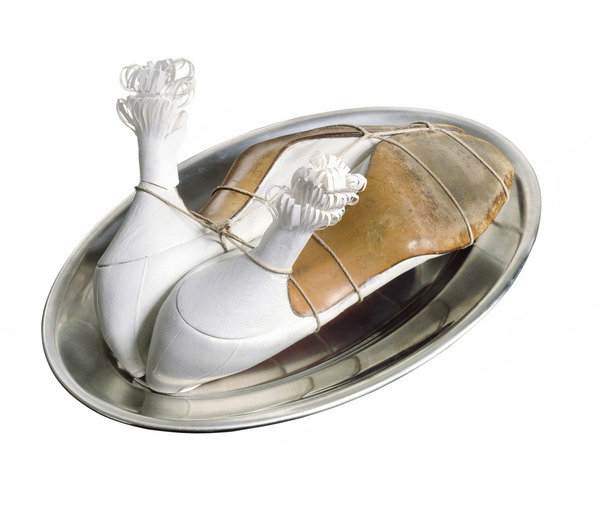Surrealism & Duchamp
dal 26/3/2013 al 4/1/2014
Segnalato da
Salvador Dali'
Joan Miro'
Meret Oppenheim
Giorgio de Chirico
Hans Arp
Dorothea Tanning
Max Ernst
Iris Muller-Westermann
26/3/2013
Surrealism & Duchamp
Moderna Museet, Stockholm
The exhibition is an opportunity to study the Moderna Museet's Duchamp collection and its outstanding collection of surrealist art, which features unique works by Salvador Dali', Joan Miro', Meret Oppenheim, Giorgio de Chirico, Hans Arp, Dorothea Tanning, Max Ernst and others. In addition to famous paintings and sculptures, surrealist objects, films and photographs, which were new artistic media in the 1920s.

curated by Iris Müller-Westermann
Surrealism & Duchamp is Moderna Museet’s next instalment in the dialogue between Duchamp and other artists in the Museum’s outstanding collection.
1920s and 1930s surrealism is one of the principal movements in modernist art and literature. The surrealists eschewed rational reality and – inspired by Sigmund Freud’s psychoanalysis – embraced irrationality and the hidden, darker sides of the human mind. Using automatic writing and dream resumés, the artists and authors tried to tap into the subconscious. The intention was that dream and reality should dissolve into an absolute reality – a super-reality (surreality). With a new kind of art, the surrealists wanted to change life and society and liberate individuals from their straightjackets.
Giorgio de Chirico is the chief pioneer of surrealist painting. In what he called his ‘metaphysical paintings’, made before the First World War, de Chirico portrayed a fictive, ghost-like world with near-photorealism. Salvador Dalí, Renée Magritte and Yves Tanguy developed their dreamlike imagery, often in a hyperrealist, figurative style, while Joan Miró created a universe of more abstract signs charged with strong symbolism. Max Ernst experimented with different techniques, including frottage and collage, to achieve painting beyond painting, where transformations and metamorphoses were central elements. His approach forced him to react to the unexpected and to surrender himself to chance.
As one of the most radical early-20th century artists, Marcel Duchamp, along with Giorgio de Chirico and Max Ernst, was a vital source of inspiration for the surrealist artists. Duchamp had introduced the use of chance and games in his work at an early stage, and his ready-mades, where he combined things he found into new objects, in the 1930s surrealist spirit, to create new symbolically-charged objects.
Duchamp, who had given up painting when he was 25, did not exhibit in Europe until the 1930s, but he had been well-known in surrealist circles since 1922, thanks to André Breton. Breton, who was the leader of the surrealist group, had written an overview of Duchamp’s works in 1934, stressing Duchamp’s unique importance to contemporary art. In 1937, Duchamp designed the entrance to Breton’s legendary gallery Gradiva in Paris, modelled on the contours of a couple embracing. Nevertheless, Duchamp consistently turned down all invitations to participate in surrealist projects: “All those exhibitions of painting and sculpture make me ill. And I prefer to avoid participating in them.”
He did take part eventually, however, in the groundbreaking exhibition of surrealist objects at Galerie Ratton in Paris in 1936. Two years later, Duchamp also designed the renowned surrealist exhibition Exposition Internationale du Surréalisme, organised by André Breton and Paul Éluard at Galerie des Beaux-Arts in Paris. This was the first completely staged art presentation in the history of art exhibitions. Duchamp’s setting invited visitors into a breathtaking, surrealist world of dreams, obsessions, surprises and dangers. Duchamp subsequently designed a further two exhibitions in New York (1942) and Paris (1947). He himself was inspired by the surrealists when producing his last major work, Étant donnés (1946-66) an installation incorporating the secret, powerful erotic fantasies that were central also in surrealism. Although Marcel Duchamp's work was periodically close to the surrealist artists, he remained an independent artist who trod his own path throughout his career.
The exhibition Surrealism & Duchamp is a new opportunity to study Moderna Museet’s internationally famous Duchamp collection and its outstanding collection of surrealist art, which features unique works by Salvador Dalí, Joan Miró, Meret Oppenheim, Giorgio de Chirico, Hans Arp, Dorothea Tanning, Max Ernst and others. In addition to famous paintings and sculptures, visitors can discover surrealist objects, films and photographs, which were new artistic media in the 1920s.
The exhibtion is supported by Deloitte.
Image: Meret Oppenheim, My Nurse, 1936 © Meret Oppenheim/BUS 2013
Press Department
press@modernamuseet.se
Kristin Ek, Press Officer
k.ek@modernamuseet.se
Mobile: +46 709 52 23 62
Surrealism & Duchamp opens to the public on Wednesday, 27 March, 2013.
The press is also welcome on 12 April at 5.00 pm, when Daniel Birnbaum, director of Moderna Museet, and Iris Müller-Westerman, curator, will be talking about surrealism and Duchamp.
Moderna Museet
Skeppsholmen, Stockholm
Opening hours
Tuesday 10-20
Wednesday-Thursday 10-18
Friday 10-20
Fridays 18-20 admission free to the Collection on Floor 4
Saturday-Sunday 10-18
Monday closed
Admission
120 SEK/100 SEK (reduced admission)
160 SEK/140 SEK Combination ticket Moderna Museet/Arkitekturmuseet



